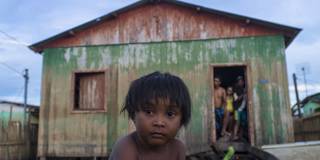With so many adverse, cascading effects, climate change both widens pre-existing social, economic, and ethnic disparities and creates new ones. Policymakers thus will need to focus on ensuring a fairer distribution of obligations not only between states but also across population segments and generations.
SAN JOSÉ – If the United States’ Pledge of Allegiance were rewritten for the world of the twenty-first century, the clause “and justice for all” could well be changed to “and climate justice for all,” given that issue’s paramount importance. A painful lesson from the last few decades – not only in the US but around the world – is that the adverse effects of climate change are not distributed equitably among countries and communities. While the climate crisis has devastating implications for all of us, United Nations Secretary-General António Guterres rightly points out that “the poor and vulnerable are the first to suffer and the worst hit.”
According to the world’s authoritative climate-science body, the Intergovernmental Panel on Climate Change (IPCC), declines in crop production and quality, increases in crop pests and diseases, and other disruptions have disproportionally affected the poor, just as increasingly frequent and extreme heat disproportionally threaten children and the elderly. As climate change simultaneously disrupts food, human, water, and ecosystem security, we can expect many more adverse cascading effects.
Extreme flooding, for example, is expected to become twice as frequent in the flood-prone areas that are home to some 450 million people. More broadly, the IPCC points to 2017 research showing that by 2030, 122 million people (mostly the poorest 20% across 92 countries) could be pushed into extreme poverty by higher food prices and other climate-driven income losses.

SAN JOSÉ – If the United States’ Pledge of Allegiance were rewritten for the world of the twenty-first century, the clause “and justice for all” could well be changed to “and climate justice for all,” given that issue’s paramount importance. A painful lesson from the last few decades – not only in the US but around the world – is that the adverse effects of climate change are not distributed equitably among countries and communities. While the climate crisis has devastating implications for all of us, United Nations Secretary-General António Guterres rightly points out that “the poor and vulnerable are the first to suffer and the worst hit.”
According to the world’s authoritative climate-science body, the Intergovernmental Panel on Climate Change (IPCC), declines in crop production and quality, increases in crop pests and diseases, and other disruptions have disproportionally affected the poor, just as increasingly frequent and extreme heat disproportionally threaten children and the elderly. As climate change simultaneously disrupts food, human, water, and ecosystem security, we can expect many more adverse cascading effects.
Extreme flooding, for example, is expected to become twice as frequent in the flood-prone areas that are home to some 450 million people. More broadly, the IPCC points to 2017 research showing that by 2030, 122 million people (mostly the poorest 20% across 92 countries) could be pushed into extreme poverty by higher food prices and other climate-driven income losses.